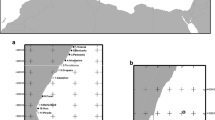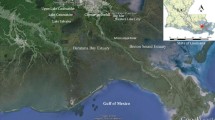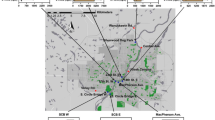Abstract
Stormwater ponds are commonly used in residential and commercial areas to control flooding. The accumulation of urban contaminants in stormwater ponds can lead to water-quality problems including nutrient enrichment, chemical contamination, and bacterial contamination. This study presents 5 years of monitoring data assessing water quality of a residential subdivision pond and adjacent tidal creek in coastal South Carolina, USA. The stormwater pond is eutrophic, as described by elevated concentrations of chlorophyll and phosphorus, and experiences periodic cyanobacterial blooms. A maximum monthly average chlorophyll concentration of 318.75 μg/L was measured in the stormwater pond and 227.63 μg/L in the tidal creek. Fecal coliform bacteria (FCB) levels were measured in both the pond and the tidal creek that exceeded health and safety standards for safe recreational use. A maximum monthly average FCB level of 1,247 CFU/100 mL was measured in the stormwater pond and 12,850 CFU/100 mL in the tidal creek. In addition, the presence of antibiotic resistant bacteria and pathogenic bacteria were detected. Low concentrations of herbicides (atrazine and 2,4-D), a fungicide (chlorothalonil), and insecticides (pyrethroids and imidacloprid) were measured. Seasonal trends were identified, with the winter months having the lowest concentrations of chlorophyll and FCB. Statistical differences between the stormwater pond and the tidal creek were also noted within seasons. The tidal creek had higher FCB levels than the stormwater pond in the spring and summer, whereas the stormwater pond had higher chlorophyll levels than the tidal creek in the summer and fall seasons. Chlorophyll and FCB levels in the stormwater pond were significantly correlated with monthly average temperature and total rainfall. Pesticide concentrations were also significantly correlated with temperature and rainfall. Pesticide concentrations in the stormwater pond were significantly correlated with pesticide concentrations in the adjacent tidal creek. Chlorophyll and FCB levels in the tidal creek, however, were not significantly correlated with levels in the pond. While stormwater ponds are beneficial in controlling flooding, they may pose environmental and human health risks due to biological and chemical contamination. Management to reduce residential runoff may improve water quality in coastal stormwater ponds and their adjacent estuarine ecosystems.
Similar content being viewed by others
References
Allen, H. K., Donato, J., Wang, H. H., Cloud-Hansen, K. A., Davies, J., & Handelsman, J. (2010). Call of the wild: antibiotic resistance genes in natural environments. Nature Reviews Microbiology, 8, 251–259.
APHA (1998). American public health association. In M. A. H. Franson (Ed.), Standard methods for the examination of water and wastewater (20 edn). Washington, D.C.: APHA.
Armbrust, K. L., & Peeler, H. B. (2002). Effects of formulation on the run-off of imidacloprid from turf. Pest Management Science, 58, 702–706.
Balthis, L. W., Hyland, J. L., Fulton, M. H., Pennington, P. L., Cooksey, C., et al. (2010). Effects of chemically spiked sediments on estuarine benthic communities: a controlled mesocosm study. Environmental Monitoring and Assessment, 161(1–4), 191–203. doi:10.1007/s10661-008-0737-0.
Brasher, C. W., DePaola, A., Jones, D. D., & Bej, A. J. (1998). Detection of microbial pathogens in shellfish with multiplex PCR. Current Microbiology, 37, 1–8.
Bricker, S. B., Clement, C. G., Pirhalla, D. E., Orlando, S. P., & Farrow, D. R. G. (1999). National Estuarine Eutrophication Assessment: Effects of Nutrient Enrichment in the Nation’s Estuaries (pp. 71). Silver Spring: U.S. Dept. of Commerce, National Oceanic and Atmospheric Administration, National Ocean Service, Special Projects Office: National Centers for Coastal Ocean Science.
Brock, L. M. (2006). Water quality nutrient dynamics, phytoplankton ecology, and land uses within defined watersheds surrounding six detention ponds on Kiawah Island, South Carolina. Master’s thesis, College of Charleston, Charleston, SC.
Caux, P.-Y., Kent, R. A., Fan, G. T., & Stephenson, G. L. (1996). Environmental fate and effects of chlorothalonil: A Canadian perspective. Critical Reviews in Environmental Science and Technology, 26(1), 45–93.
Davies, C. M., Long, J. A., Donald, M., & Ashbolt, N. J. (1995). Survival of fecal microorganisms in marine and freshwater sediments. Applied and Environmental Microbiology, 61(5), 1888–1896.
DeLorenzo, M. E., & Fulton, M. H. (2009). Water Quality and Harmful Algae in Southeastern Coastal Stormwater Ponds. NOAA Technical Memorandum (Vol. 93, pp. 27): National Ocean Service, National Centers for Coastal Ocean Science.
DeLorenzo, M. E., Scott, G. I., & Ross, P. E. (2001). Toxicity of pesticides to aquatic microorganisms: A review. Environmental Toxicology and Chemistry, 20(1), 84–98.
DeLorenzo, M. E., & Serrano, L. (2006). Mixture toxicity of the antifouling compound irgarol to the marine phytoplankton species Dunaliella tertiolecta. Journal of Environmental Science and Health, 41B, 1349–1360.
DeLorenzo, M. E., Serrano, L., Chung, K. W., Hoguet, J., & Key, P. B. (2006). Effects of the insecticide permethrin on three life stages of the grass shrimp, Palaemonetes pugio. Ecotoxicology and Environmental Safety, 64(2), 122–127.
DePaola, A., Motes, M. L., Cook, D. W., Veazey, J., Garthright, W. E., & Blodgett, R. (1997). Evaluation of an alkaline phosphatase-labeled DNA probe for enumeration of Vibrio vulnificus in Gulf Coast oysters. Journal of microbiological methods, 29, 115–120.
DifcoLaboratories (1998). Difco manual: Division of Becton Dickinson (11 edn., pp. 352–353). Sparks: Difco.
Feldman, K. A., Mohle-Boetani, J. C., Ward, J., Furst, K., Abrott, S. I., et al. (2002). A cluster of Escherichi coli 0157: Nonmotile infections associated with recreational exposure to stormwater pond water. Public Health Reports, 117, 380–385.
Friberg-Jensen, U., Wendt-Rasch, L., Woin, P., & Christoffersen, K. (2003). Effects of the pyrethroid insecticide, cypermethrin, on a freshwater community studied under field conditions. I. Direct and indirect effects on abundance measures of organisms at different trophic levels. Aquatic Toxicology, 63(4), 357–371.
Glover, H. E., & Morris, I. (1979). Photosynthetic carboxylating enzymes in marine phytoplankton. Limnology and Oceanography, 23, 510–519.
Gooch, J. A., DePaola, A., Kaysner, C. A., & Marshall, D. L. (2001). Evaluation of two direct plating methods using nonradioactive probes for enumeration of Vibrio parahaemolyticus in oysters. Applied and Environmental Microbiology, 67, 721–724.
Harper, H. E., Pennington, P. L., Hoguet, J., & Fulton, M. H. (2008). Lethal and sublethal effects of the pyrethroid, bifenthrin, on grass shrimp (Palaemonetes pugio) and sheepshead minnow (Cyprinodon variegatus). Journal of Environmental Science and Health, 43B(6), 476–483.
Horner, R. L. (1996). Stormwater runoff analysis for the Lake Edmonds drainage basin. Prepared for the Lake Edmonds Home and Property Owners Association (LEHPOA), Reprints available (lorimarserrrano@yahoo.com; pp. 10).
Key, P. B., Chung, K. W., Siewicki, T., & Fulton, M. H. (2007). Toxicity of three pesticides individually and in mixture to larval grass shrimp (Palaemonetes pugio). Ecotoxicology and Environmental Safety, 68, 272–277.
Konwick, B. J., Garrison, A. W., Avants, J. K., & Fisk, A. T. (2006). Bioaccumulation and biotransformation of chiral triazole fungicides in rainbow trout (Oncorhynchus mykiss). Aquatic Toxicology, 80(4), 372–381.
Kummerer, K. (2001). Drugs in the environment: Emission of drugs, diagnostic aids and disinfectants into wastewater by hospitals in relation to other sources—A review. Chemosphere, 45, 957–969.
Kummerer, K. (2004). Resistance in the environment. Journal of Antimicrobial Chemotherapy, 54, 311–320.
Lewitus, A. J., Schmidt, L. B., Mason, L. J., Kempton, J. W., Wilde, S. B., et al. (2003). Harmful algal blooms in South Carolina residential and golf course ponds. Population and Environment, 24(5), 387–413.
Mallin, M. A., Ensign, S. H., Wheeler, T. L., & Mayes, D. B. (2002). Pollutant removal efficacy of three wet detention ponds. Journal of Environmental Quality, 31, 654–660.
McCarthy, S. A., DePaola, A., Cook, D. W., Kaysner, C. A., & Hill, W. E. (1999). Evaluation of alkaline phosphatase- and digoxigeninlabeled probes for detection of the thermolabile hemolysin (tlh) gene of Vibrio parahaemolyticus. Letters in Applied Microbiology, 28, 66–70.
NCCLS (2003). Methods for dilution antimicrobial susceptibility tests for bacteria that grow aerobically; approved standard (6th edn). Wayne: NCCLS (Vol. 23, NCCLS document M7-A6, Vol. 2).
Parveen, S., Murphree, R. L., Edmiston, L., Kaspar, C. W., Portier, K. M., et al. (1997). Association of multiple-antibiotic-resistance profiles with point and non-point sources of Escherichia coli in Apalachicola Bay. Applied and Environmental Microbiology, 63, 2607–2612.
Rand, G. M. (2001). Hazard assessment of Resmethrin: I. Effects and fate in aquatic systems. Ecotoxicology, 11(2), 101–111.
SCDHEC (2007). State of the Knowledge Report: Stormwater Ponds in the Coastal Zone. Columbia: South Carolina Dept of Health and Environmental Control, Office of Ocean and Coastal Resource Management.
Scott, G. I., Fulton, M. H., Wirth, E. F., Chandler, G. T. , Key, P. B., et al. (2002). Toxicological studies in tropical ecosystems: an ecotoxicological risk assessment of pesticide runoff in South Florida estuarine ecosystems. Journal of Agricultural and Food Chemistry, 50(15), 4400–4408.
Serrano, L., & DeLorenzo, M. E. (2008). Water quality and restoration in a coastal subdivision stormwater pond. Journal of Environmental Management, 88(1), 43–52.
Siewicki, T. C., Pullaro, T., Pan, W., McDaniel, S., Glenn, R., & Stewart, J. (2007). Models of total and presumed wildlife sources of fecal coliform bacteria in coastal ponds. Journal of Environmental Management, 82(1), 120–132.
Solomon, K. R., Baker, D. B., Richards, R. P., Dixon, K. R., Klaine, S. J., et al. (1996). Ecological risk assessment of atrazine in North American surface waters. Environmental Toxicology and Chemistry, 15(1), 31–76.
Stout, D. M., Bradham, K. D., Egeghy, P. P., Jones, P. A., Croghan, C. W., et al. (2009). American healthy homes survey: A national study of residential pesticides measured from floor wipes. Environmental Science and Technology, 43, 4294–4300.
Taniguchi, H., Hirano, H., Kubomura, S., Higashi, K., & Mizuguchi, Y. (1986). Comparison of the nucleotide sequences of the genes for the thermostable direct hemolysin and the thermolabile hemolysin from Vibrio parahaemolyticus. Microbial Pathogenesis, 1, 425–432.
USEPA (2001). Ambient water quality criteria recommendations. Information supporting the development of state and tribal nutrient criteria. Lakes and reservoirs in nutrient ecoregion XIV (Vol. 4304). Washington, D.C.: United States Environmental Protection Agency, Office of Water.
USES (2004). Urbanization and Southeastern Estuarine Systems. University of South Carolina, Final Project Report Charleston, SC: NOAA, National Ocean Service, Center for Coastal Environmental Health and Biomolecular Research.
Webster, L. F., Thompson, B. C., Fulton, M. H., Chestnut, D. E., et al. (2004). Identification of sources of Escherichia coli in South Carolina estuaries using antibiotic resistance analysis. Journal of Experimental Marine Biology and Ecology, 298(2), 179–195.
Weston, D. P., Holmes, R. W., You, J., & Lydy, M. J. (2005). Aquatic toxicity due to residential use of pyrethroid insecticides. Environmental Science and Technology, 39(24), 9778–9784.
Whitlock, J. E., Jones, D. T., & Harwood, V. J. (2002). Identification of the sources of fecal coliforms in an urban watershed using antibiotic resistance analysis. Water Research, 36, 4273–4282.
WHO (1999). Toxic Cyanobacteria in Water: A guide to their public health consequences, monitoring and management. In I. Chorus, & J. Bartram (Eds.), (p. 400). Great Britain: St Edmundsbury Press.
Wiggins, B. A., Andrews, R. W., Conway, R. A., Corr, C. L., Dobratz, E. J., et al. (1999). Use of antibiotic resistance analysis to identify nonpoint sources of fecal pollution. Applied and Environmental Microbiology, 65, 3483–3486.
Wong, P. K. (2000). Effects of 2,4-d, glyphosate and paraquat on growth, photosynthesis and chlorophyll-a synthesis of Scenedesmus quadricauda Berb 614. Chemosphere, 41(1–2), 177–182.
Wright, A. C., Miceli, G. A., Landry, W. L., Christy, J. B., Watkins, W. D., Morris, et al. (1993). Rapid identification of Vibrio vulnificus on nonselective media with an alkaline phosphatase-labeled oligonucleotide probe. Applied and Environmental Microbiology, 59, 541–546.
Author information
Authors and Affiliations
Corresponding author
Rights and permissions
About this article
Cite this article
DeLorenzo, M.E., Thompson, B., Cooper, E. et al. A long-term monitoring study of chlorophyll, microbial contaminants, and pesticides in a coastal residential stormwater pond and its adjacent tidal creek. Environ Monit Assess 184, 343–359 (2012). https://doi.org/10.1007/s10661-011-1972-3
Received:
Accepted:
Published:
Issue Date:
DOI: https://doi.org/10.1007/s10661-011-1972-3




